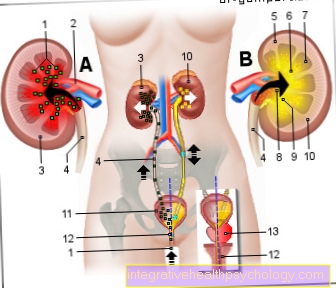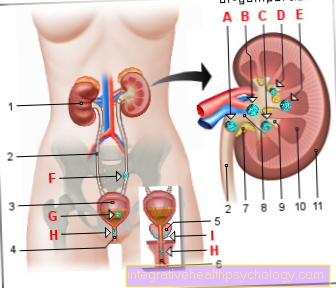Kaposi's sarcoma
definition
Kaposi's sarcoma is a cancer that is characterized by the formation of vascular conglomerates in the skin.
These become visible in the form of blue and reddish knots or spots that can be the size of a palm.
The sarcoma is named after Moritz Kaposi, who first described it in the 19th century as "Idiopathic multiple pigment sarcoma of the skin”Classified. The disease usually develops in the case of immune insufficiency, as it is present in AIDS patients or people with other autoimmune diseases. The course of the disease varies: there are harmless courses that do not cause symptoms for years, as well as highly aggressive courses that can quickly be fatal.

causes
The trigger of Kaposi's sarcoma is the human herpes virus 8 (HHV-8). Since this virus was only discovered in the 1990s, the person who first described it was not yet able to establish a connection with the genesis of the disease. HHV-8 belongs to the herpes virus group and is transmitted sexually and perinatally, i.e. during childbirth. In addition, transmission by means of smear infection, i.e. by exchanging body fluids, is also possible. At this point it should be mentioned that the HHV-8 infection is necessary in order to develop Kaposi's sarcoma, but at the same time there must be other genetic characteristics or an impairment of the immune system.
On the one hand, there is the classic form of Kaposi's sarcoma. This form mainly affects men over 60 who are of Italian, Jewish or Eastern European origin. In this case, the course can be classified as mild.
On the other hand, the endemic Kaposi sarcoma has been described in Africa, which occurs independently of HIV and can also affect small children.
By far the most common form is AIDS-associated Kaposi's sarcoma. In this case there is an immunodeficiency. If the person infected with HHV-8 is immunocompetent, their immune system will manage to keep the virus in check and the person will not develop any symptoms. Only when an immune insufficiency is developed does the virus break out and cause the malignant vascular conglomerates of the skin. Since Kaposi's sarcoma is particularly common due to an HIV infection and an AIDS disease (20,000 times more often than in healthy people), it has also been described as an “AIDS-defining disease”. The greatest risk group for AIDS and Kaposi's sarcoma are homosexual men.
But it must also be added that with the development of highly effective HIV drugs, the number of Kaposi's sarcomas has decreased.
You may also be interested in the following article: These are the symptoms of AIDS.
diagnosis
A biopsy, i.e. a tissue sample, is essential for the diagnosis of Kaposi's sarcoma. This is evaluated histopathologically.
In addition, as already described, there must be an immunodeficiency. This is the case with AIDS. If an HIV infection is confirmed and dark skin lumps also appear, the diagnosis of Kaposi's sarcoma is obvious. If the suspicion is confirmed as a so-called dissemination, that is, a spread of the tumor to the internal organs, this can be visualized using CT, chest X-ray and abdominal ultrasound.
I recognize Kaposi's sarcoma by these symptoms
Kaposi's sarcoma is primarily characterized by the appearance of many blue or bluish-red spots, up to the size of a palm, that form on the surface of the skin. These vascular conglomerates occur increasingly on the legs, but also on the face, the oral mucosa and the trunk area.
As the disease progresses, the skin lumps enlarge, and painful ulcerations and open spots can also develop.
If Kaposi's sarcoma spreads to the lymphatic vessels, massive edema can occur. This means that water is stored in the body, especially on the legs. So these swell.
If gastrointestinal infestation is present, gastrointestinal bleeding can occur. This is then expressed by vomiting blood or tarry stools. The expression of the sarcoma on the skin and in the gastrointestinal tract can occur side by side, but also individually.
These are early signs
The signs of Kaposi's sarcoma in the early stages depend on which organ the sarcoma affects first and which localization is detected. If the skin is affected, multiple vascular nodules appear, which can enlarge and expand as the disease progresses. These nodules can be painful, but not always.
If Kaposi's sarcoma manifests in the gastrointestinal tract, patients are often asymptomatic at first. As the disease progresses, bleeding of the stomach or intestines may occur. This is then expressed by tarry stools or vomiting blood.
localization
foot
As already mentioned, Kaposi's sarcoma very often occurs symmetrically on the legs, trunk and face. Kaposi's sarcoma often begins on the feet and spreads towards the middle of the body. It manifests itself in the form of bluish-purple, flat to nodular skin lesions. These can painfully ulcerate, especially on the feet, where the pressure load and wearing shoes create a lot of friction.
face
The same skin lesions can appear on the face as on the rest of the body. However, they can be more psychologically stressful for those affected, as they are visible to everyone at first glance.
therapy
The basic rule is that, if possible, the trigger of Kaposi's sarcoma must be combated or eliminated.
The classic Kaposi sarcoma, which predominantly affects men of older age and from the Mediterranean region, usually responds well to radiation therapy and chemotherapy.
In the case of immunosuppression, a reduction in immunosuppressive drugs can lead to a complete regression of Kaposi's sarcoma.
If the cause of Kaposi's sarcoma is AIDS, then drug, antiretroviral therapy is a successful treatment for both HIV and Kaposi's sarcoma.
Despite this guide, you should decide about the individual treatment with your attending physician.
course
The course and prognosis of the disease logically depend on the severity of the disease. If the skin is only locally affected, the patient has a better prognosis than if the internal organs are affected in a disseminated manner.
The course of the disease depends heavily on whether adequate therapy is initiated in good time. With HIV therapy, Kaposi's sarcoma often regresses.
Here, too, the course depends entirely on the patient's health situation and the therapy initiated.





























